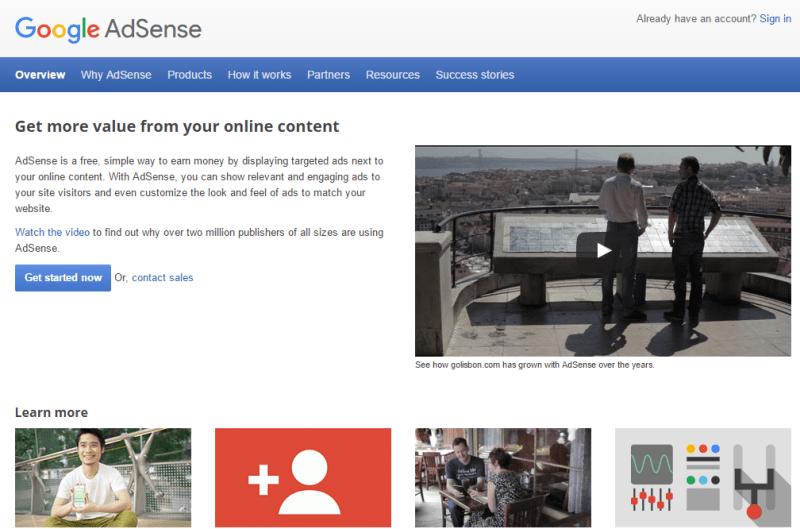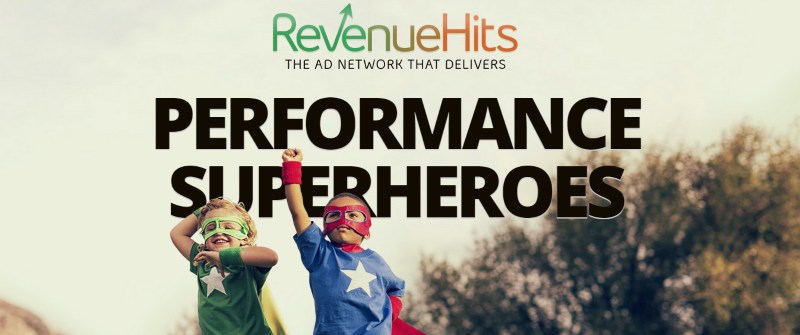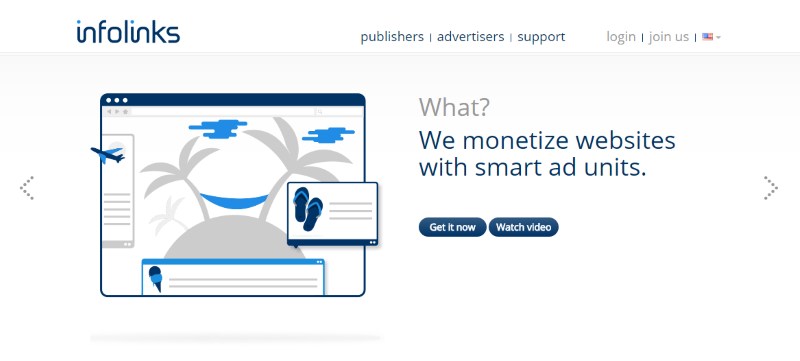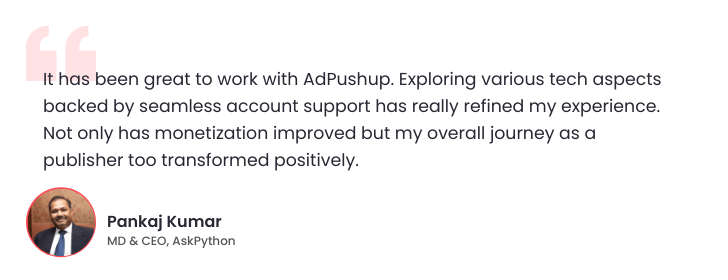What are the best ad networks for small businesses and publishers? We list the top 7 ad networks with low traffic requirements and high fill rates.
You’re a small fish in a big pond. Being a website owner, whether a business or a blogger, you’ll find that many ad networks simply won’t accept your website.
There are several reasons for rejection – from your niche to having too little visitors to your website not meeting the network’s requirements.
It’s much harder for small businesses and publishers to get accepted into ad networks.
But, that doesn’t mean there aren’t plenty of networks that would love to display their ads on your website.
We’ve been researching which ad networks are best for smaller publishers based on the following criteria:
- Low entry requirement
- High inventory utilization
- Reliable payouts
The networks that best fit these criteria are:
1. Media.net
Media.net runs contextual ads and is fueled by the Yahoo! Bing Network. A major advertiser, the network boasts high-quality advertisers with millions of sponsored ads. Mix this together with no minimum traffic requirement and multiple ad formats, and you have the perfect ad network for smaller publishers.
Mobile ads can even be displayed through the platform. Robust targeting, dynamic optimization, and innovative ad units make Media.net a very attractive choice for publishers. The company also offers:
- No traffic requirements.
- All CPC offers.
- Dozens of ad size.
- Payment terms of NET 30 ($100 threshold).
Payments are sent via PayPal and wire transfer. One thing I really like about this network is that you’ll be connected with your own personal account manager, and contacting support is effortless.
The company states 100% fill rate across all verticals. Several ad types are offered, too, from rich media and interstitial ads to images and in-content ads.
Media.net is slowly becoming AdSense’s biggest threat in the industry.
2. Google AdSense

Google AdSense is still the best ad network for small publishers. A brand that everyone is familiar with, Google offers a near 100% fill rate with high-quality ads and decent overall performance in terms of revenue.
AdSense has the following publisher benefits:
- No traffic requirements.
- Net 30 payments ($100 threshold)
- CPC and CPM offers
You must adhere to AdSense’s terms of service and follow their program policies.
Aside from a high fill rate, reliable payouts, and a low entry requirement, AdSense is easy to implement into your website. A small code snippet is all that’s needed to get started, and you can display up to 3 ad units on a page.
Contextually, Google will choose ads that are most relevant to your page’s content.
And, the company has video resources that are perfect for a small publisher. These videos include steps to optimize your ads and can help you make more money as a publisher.
3. RevenueHits

RevenueHits is a massive network that offers a 100% fill rate and displays over 2 billion ads per day. Established in 2008, the company is known for their reliable payments and offers a wide variety of ad formats, including:
- Display / rich media
- Text ads
- Popups/unders
- Apps and widget monetization
- XML feeds
- Custom formats
Finding a network that is willing to work with publishers of all sizes and offers custom formats is a rarity. Meeting the needs of publishers, you can request a unique ad format, and the company may comply if it’s a reasonable request.
The company states some publishers receive an eCPM of $30, but that’s an exceptional case.
What you need to know is that:
- There are no traffic requirements to join.
- Payment is sent wire, PayPal or Payoneer on NET 30 terms.
- Fill rate is 100%.
RevenueHits is one of the biggest ad publishers in the world in terms of inventory, and the company always pays on time.
4. Infolinks

Infolinks offers a lot of different ad types that extend well beyond the company’s in-text ads that they first started with. Infolinks is reliable and offers five unique ad types that are a little different than what most publishers are accustomed to:
- InFold
Displayed in the fold at the bottom of the screen.
- InScreen
An interstitial ad that is displayed between page views and takes up all or most of the screen.
- InText
Ads placed within the text of your most valuable keywords.
- InTag
Ads displayed in relation to the context of a page.
- InFrame
Ads that fit into the right or left side of the screen where white space normally exists.
The variety of ad types allows you to test different optimization methods by integrating different ad units. For small publishers, you’ll be happy to know that:
- There are no traffic requirements.
- Payment is done on NET 45 ($50 – $100 threshold) basis.
The threshold is determined by your method of payment. PayPal and Payoneer have a $50 payout threshold while Bank Wire Transfer has a $100 threshold.
And, publishers receive 70% revenue share for ads displayed. Fill rate is not reported, but from personal experience, I’d say it’s near or at 100%.
5. Clicksor

Delivering ads for over 12 years, Clicksor displays ads in 196 countries and has 150,000 premium publishers in their network. Serving over 3 million ads per hour, they’re an easy network to join and integrate into your website.
Payments are done a little differently with a NET 15 schedule. Payments are sent out every Thursday of the month.
When you join Clicksor, you’ll enjoy:
- NET 15 payment terms ($50 threshold).
- Up to 85% revenue share.
- Several ad unit options.
- Low traffic requirements.
Most websites will be able to get into the Clicksor network, but there’s a website approval process. Several publishers state that the minimum requirement is 5,000 page views per day, but I couldn’t verify this claim.
Average earnings are listed on the network’s website and are as follows:
- $0.035 per click for text ads and graphic banners.
- $0.20 per 1000 impressions using graphic and rich media banners.
- $0.0025 per pop-under and interstitial ad served.
One requirement that I did want to mention is that 50% or more of your traffic must come from the US, CA or GB.
Revenue isn’t high, but payments are consistent and reliable, with several ad formats that can be mixed with other networks listed.
6. BidVertiser

BidVertiser network is a little different due to their monetization method – in a good way. Publishers will earn money each time an ad is clicked and also when a conversion takes place for the advertiser.
A neat point-and-click tool allows you to customize the way ads will look on your site, and IAB formats and mobile formats are available.
All of the ads displayed on your website will be the highest possible. The way the company’s ads work is through a bidding system where advertisers can bid on your ad space. As a result, you’ll receive the maximum revenue possible and work with a system that consistently improves over time.
When signing up for their network, you’ll enjoy:
- NET 30 payments via PayPal ($10 threshold).
- No minimum traffic requirements.
- Near 100% fill rate.
BidVertiser is another company that doesn’t state their current fill rate publically. But, according to other publishers and myself, it’s near 100%.
7. AdCash

AdCash almost didn’t make our list due to a PayPal issue that delayed payments a few months ago. However, this issue has since been rectified. AdCash offers a lot of ad formats that are beneficial for small publishers, such as:
- Display banners
- Site-under
- Footer
- Slide-in
- Interstitial
- Background
- In-app ads
The main reason for using this company is this: they provide diversity in your revenue options. And, the company also offers CPM and CPA commission types.
Note: AdCash does not pay on a CPC basis.
Many publishers complain that the company doesn’t pay well, but not all traffic will convert well. From personal experience, if the banners are not turning out to be profitable, use the pop-unders for best results.
When you sign up for AdCash, you’ll enjoy:
- No minimum traffic requirements.
- NET30 payment terms (100 euro threshold).
- High fill rates.
- Intuitive reporting and interface.
AdCash comes in lower on our list because they use a CPA commission type, which may be difficult to leverage for publishers and businesses especially. If your traffic converts poorly, the company’s pop-under format does pay decent eCPM rates.
Before you leave, we’d like to do a little self plug about ourselves too. Take a look at what AdPushup does and why we’re hand-picked by Google as a certified publishing partner.
AdPushup is Google Certified Publishing Partner. Over the years, we have helped more than 300 web publishers sustainably increase their ad CTRs, CPMs, and overall revenues without compromising on UX.
Got a minute? Take a look at how we delivered a 534% ad revenue uplift in 6 Months for CCNA7. If you want to learn how our technology can do the same for you, go ahead and request a demo.

Traffic Considerations and Website Niche
A quick note about most (if not all) of the ad networks on this list:
- Fraudulent traffic will not be tolerated and will cause your account to be terminated.
- Certain niches, such as gambling, will be against the terms of service of the company.
- All publishers, despite traffic requirements, may have their websites rejected from each network.
Many of the networks for smaller publishers will pay less. We’ve done our best to put the highest paying networks at the top of this list, but revenue will be dependent on your traffic and niche.
FAQs
The ad network is a technology platform that facilitates the sale of ad inventory between publishers and advertisers. The term refers exclusively to digital media and online advertising.
Ad networks pool unsold ad inventory from publishers and sell it to advertisers. The companies make money by taking a cut of ad revenue, sometimes by marking up inventory before selling it.
The ad server lets publishers and advertisers manage their ads themselves, from setting up the server to tracking and managing them, whereas the ad network helps advertisers find the right publishing platforms for their ads.

Shubham is a digital marketer with rich experience working in the advertisement technology industry. He has vast experience in the programmatic industry, driving business strategy and scaling functions including but not limited to growth and marketing, Operations, process optimization, and Sales.



![CTV vs OTT Advertising: Which one is Right Pick for Publishers? + [6 Bonus Strategies] Ott vs Ctv](png/featured-image-270x180.png)


